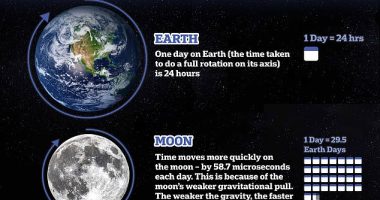NASA has big plans to put humans back on the Moon in 2025 and will be testing out its new Space Launch System (SLS) later this year.
The US space agency’s SLS rocket is the most powerful ever built and the plan is to send it hurtling around the Moon this summer.
Nasa’s Artemis Moon mission involves three different stages each costing around $4billion (£3.3billion).
When you take into account all the new equipment and the many years that have and will go into Artemis, the whole mission is estimated to cost $93 billion (£76billion).
Artemis 1
The first part of the mission to put humans back on the Moon is called Artemis 1 and it’s been pushed back several times already.


Rumors now suggest Artemis 1 could be blasted off sometime in August for an up to 42 day mission around the Moon.
The flight will be testing out hardware so that Nasa can land the first woman and the first person of color on the Moon by 2025.
That crewed mission is being referred to as Artemis 3 and a lot has to happen before it can take place.
Artemis 1 isn’t a crewed mission but it needs to loop around the Moon to test three key components.
Most read in Tech
These are Nasa’s Space Launch System (SLS), its Orion spacecraft, and the European Service Module (ESM).
The Orion spacecraft and the ESM should get within 62 miles of the lunar surface and then travel 40,000 miles beyond this.
Once looping around the dark side of the Moon, the rocket should land in the Pacific Ocean off the coast of San Diego.
Nasa completed a “wet dress rehearsal” of the SLS back in March.
It was originally hoping for a May launch date but has decided to conduct more tests before then.
The launch date will depend on weather conditions and where the Moon is in its lunar cycle.
Artemis 2
If Artemis 1 all goes to plan this year, the SLS rocket could be taking humans around the Moon in 2024.
This will be the second part of the Artemis program and it’s aptly called Artemis 2.
Although it will be manned, humans won’t be getting off on the Moon.
Instead, they’ll perform a flyby and then return to Earth having thoroughly tested out all the equipment.
Artemis 2 involves a four-person crew flying the Orion module 5523 miles beyond the Moon.
This will be the furthest humans have gone into space.
Artemis 3
After all those tests, Nasa will have finally reached the time for Artemis 3.
This will be a historical crewed mission to the Moon.


If all goes to plan, it will be the first time a human has stood on the Moon in 53 years and the first time a woman and person of color has been there.
The lucky astronauts will investigate the lesser-known dark side of the Moon and its lunar ice.
We pay for your stories!
Do you have a story for The US Sun team?










